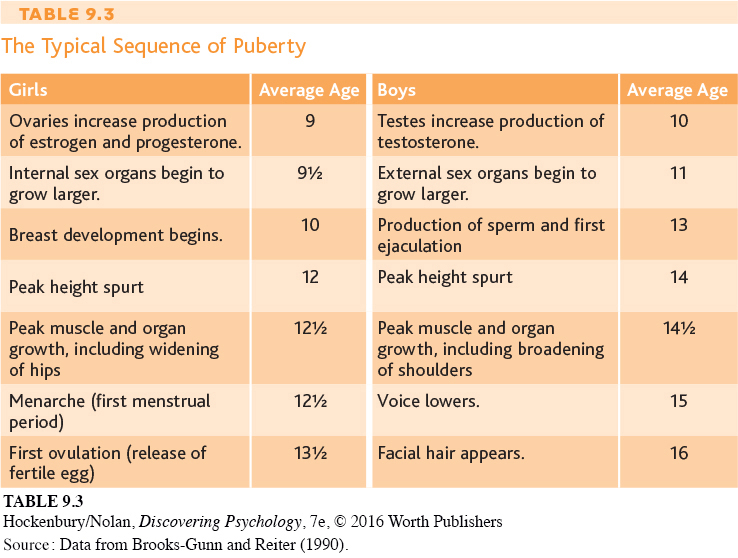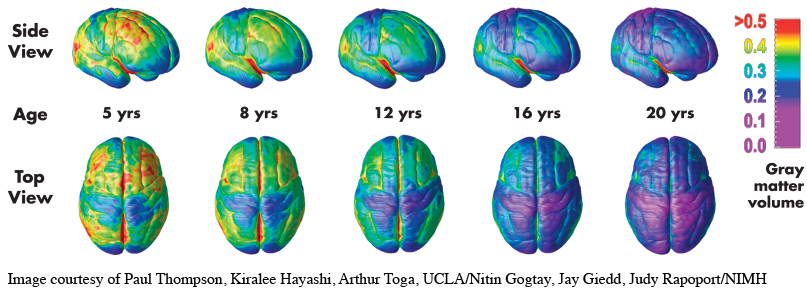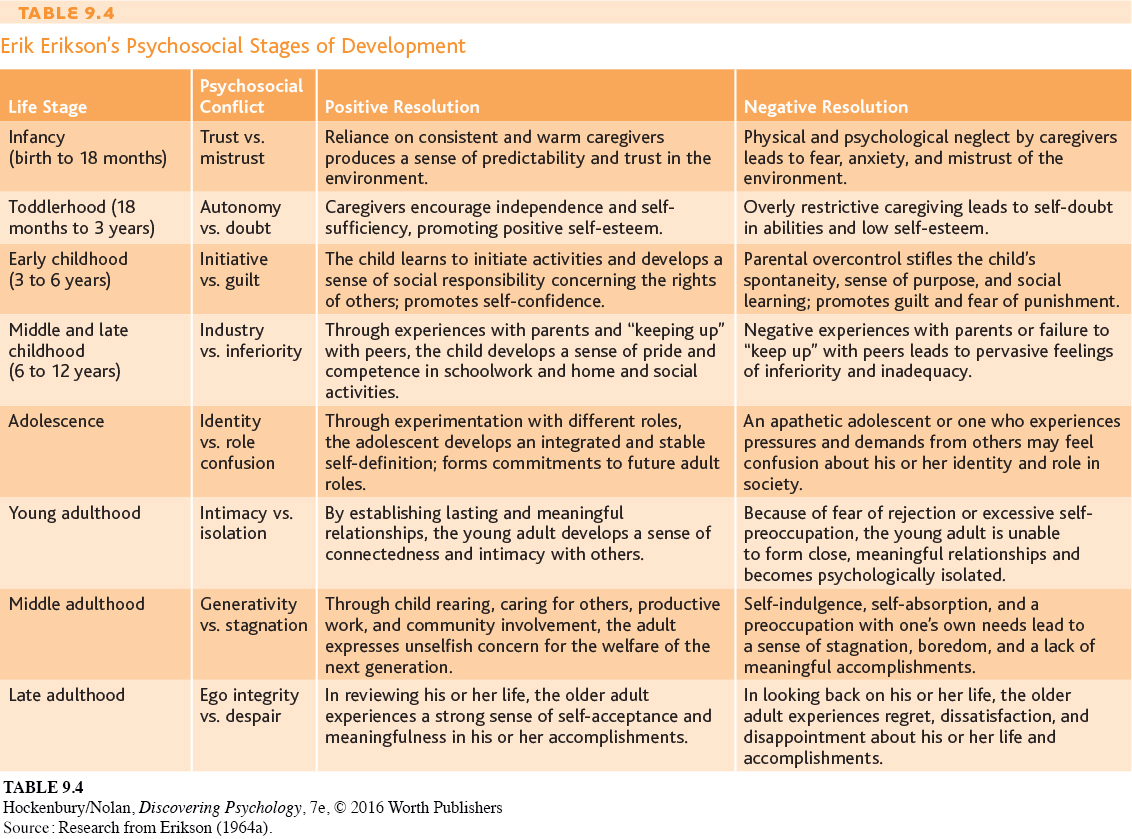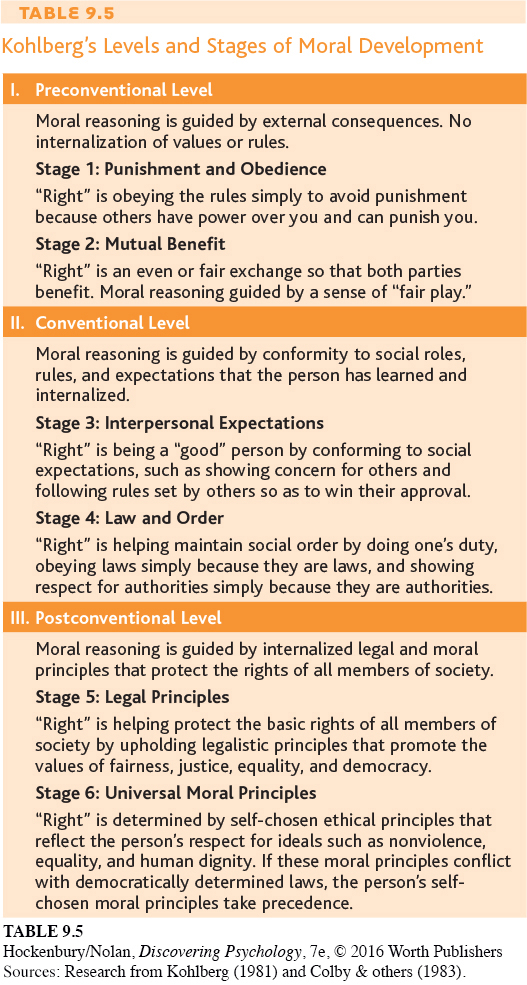Adolescence

KEY THEME
Adolescence is the stage that marks the transition from childhood to adulthood.
KEY QUESTIONS
What factors affect the timing of puberty?
What characterizes adolescent relationships with parents and peers?
What is Erikson’s psychosocial theory of lifespan development?
Adolescence is the transitional stage between late childhood and the beginning of adulthood. Although it can vary by individual, culture, and gender, adolescence usually begins around age 11 or 12. It is a transition marked by sweeping physical, social, and cognitive changes as the individual moves toward independence and adult responsibilities. Outwardly, the most noticeable changes that occur during adolescence are the physical changes that accompany the development of sexual maturity. We’ll begin by considering those changes, then turn to the aspects of social development during adolescence. Following that discussion, we’ll consider some of the cognitive changes of adolescence, including identity formation.
Physical and Sexual Development
Nature seems to have a warped sense of humor when it comes to puberty, the physical process of attaining sexual maturation and reproductive capacity that begins during the early adolescent years. As you may well remember, physical development during adolescence sometimes proceeds unevenly. Feet and hands get bigger before legs and arms do. The torso typically develops last, so shirts and blouses sometimes don’t fit quite right. And the left and right sides of the body can grow at different rates. The resulting lopsided effect can be quite distressing: One ear, foot, testicle, or breast may be noticeably larger than the other. Thankfully, such asymmetries tend to even out by the end of adolescence. For transgender people like James, however, puberty offers an additional challenge. Their bodies are developing into the gender that they do not identify with.
Although nature’s game plan for physical change during adolescence may seem haphazard, puberty actually tends to follow a predictable sequence for each sex. These changes are summarized in Table 9.3.

PRIMARY AND SECONDARY SEX CHARACTERISTICS
The physical changes of puberty fall into two categories. Internally, puberty involves the development of the primary sex characteristics, which are the sex organs that are directly involved in reproduction. For example, the female’s uterus and the male’s testes enlarge in puberty. Externally, development of the secondary sex characteristics, which are not directly involved in reproduction, signals increasing sexual maturity. Secondary sex characteristics include changes in height, weight, and body shape; the appearance of body hair and voice changes; and, in girls, breast development.
As you can see in Table 9.3, females are typically about two years ahead of males in terms of physical and sexual maturation. For example, the period of marked acceleration in weight and height gains, called the adolescent growth spurt, occurs about two years earlier in females than in males. Much to the chagrin of many sixth-
The statistical averages in Table 9.3 are informative, but—
Thus, it’s entirely possible for some adolescents to have already completed physical and sexual maturation before their classmates have even begun puberty. Yet they would all be considered well within the normal age range for puberty (Sun & others, 2002).

Less obvious than the outward changes associated with puberty are the sweeping changes occurring in another realm of physical development: the adolescent’s brain. We discuss these developments in the Focus on Neuroscience on page 388.
FACTORS AFFECTING THE TIMING OF PUBERTY
Although you might be tempted to think that the onset of puberty is strictly a matter of biological programming, researchers have found that both genetics and environmental factors play a role in the timing of puberty. Genetic evidence includes the observation that girls usually experience menarche at about the same age their mothers did (Ersoy & others, 2005). And, not surprisingly, the timing of pubertal changes tends to be closer for identical twins than for nontwin siblings (Mustanski & others, 2004).

FOCUS ON NEUROSCIENCE
The Adolescent Brain: A Work in Progress
For many adolescents, the teenage years, especially the early ones, seem to seesaw between moments of exhilaration and exasperation. Impressive instances of insightful behavior are counter-
To track changes in the developing brain, neuroscientists Jay Giedd, Elizabeth Sowell, Paul Thompson, and their colleagues have used MRI to repeatedly scan the brains of normal kids and teenagers. One striking insight produced by their studies is that the human brain goes through not one but two distinct spurts of brain development—
Earlier in the chapter, we described how new neurons are produced at an astonishing rate during the first months of prenatal development. By the sixth month of prenatal development, there is a vast overabundance of neurons in the fetal brain. During the final months of prenatal development, neurons that don’t make connections are “pruned” or eliminated. During infancy and early childhood, the brain’s outer gray matter continues to develop and grow. The tapestry of interconnections between neurons becomes much more intricate as dendrites and axon terminals multiply and branch to extend their reach. White matter also increases as groups of neurons develop myelin, the white, fatty covering that insulates some axons, speeding communication between neurons.
Outwardly, these brain changes are reflected in the increasing cognitive and physical capabilities of the child. But in the brain itself, the “use-
By 6 years of age, the child’s brain is about 95 percent of its adult size. The longitudinal MRI studies of normal kids and adolescents revealed that a second wave of gray matter overproduction occurred just prior to puberty. This late childhood surge of cortical gray matter is not due to the production of new neurons. Rather, the size, complexity, and connections among neurons all increase.

This increase in gray matter peaks at about age 11 for girls and age 12 for boys (Toga & others, 2006). And this surge is followed by a second round of neuronal pruning during the teenage years (Giedd & others, 2009; Toga & others, 2006).
Pruning Gray Matter from Back to Front
The color-
The MRI images reveal that as the brain matures, neuronal connections are pruned and gray matter diminishes in a back-
The last brain area to experience pruning and maturity is the prefrontal cortex. This is significant because the prefrontal cortex plays a critical role in many advanced or “executive” cognitive functions, such as a person’s ability to reason, plan, organize, solve problems, and decide. And when does the prefrontal cortex reach full maturity? According to the MRI studies, not until people reach their mid-
This suggests that an adolescent’s occasional impulsive or immature behavior is at least partly a reflection of a brain that still has a long way to go to reach full adult maturity (Casey, 2013; Casey & Caudle, 2013). During adolescence, emotions and impulses can be intense and compelling. But the parts of the brain that are responsible for exercising judgment are still maturing (Luna & others, 2013). The result can be behavior that is immature, impulsive, unpredictable—

Environmental factors, such as nutrition and health, also influence the onset of puberty. Generally, well-
For example, 150 years ago the average age of menarche in the United States and other developed countries was about 17 years old. Today it is about 13 years old. Boys, too, are beginning the physical changes of puberty about a year earlier today than they did in the 1960s (Irwin, 2005).
Body size, nutrition, and degree of physical activity are also related to the timing of puberty (Aksglaede & others, 2009; Cheng & others, 2012). In general, heavier children and those with poorer dietary habits begin puberty earlier than do lean children and those who tend to eat healthier food. Girls who are involved in physically demanding athletic activities, such as gymnastics, figure skating, dancing, and competitive running, can experience delays in menarche of up to two years beyond the average age (Brooks-
Interestingly, the timing of puberty is also influenced by the absence of the biological father in the home. Several studies have found that girls raised in homes in which the biological father is absent tend to experience puberty earlier than girls raised in homes where the father is present (Bogaert, 2005, 2008; Neberich & others, 2010). In another large study, both boys and girls experienced accelerated physical development in homes where fathers were absent (Mustanski & others, 2004).
Why would the absence of a father affect the timing of puberty? A stressful home environment may play a role. In families marked by marital conflict and strife, girls enter puberty earlier, regardless of whether the father remains or leaves (Saxbe & Repetti, 2009). And the financial problems that often accompany single parenthood also appear to play a role in early puberty among girls, likely because financial problems are an indicator of a stressful environment (Culpin & others, 2014). In general, negative and stressful family environments are associated with an earlier onset of puberty, while positive family environments are associated with later physical development (Ellis & Essex, 2007; James & others, 2012). Although the mechanisms are not completely clear, it may be that stressful family events increase many of the same hormones that are involved in triggering puberty.
EFFECTS OF EARLY VERSUS LATE MATURATION
Adolescents tend to be keenly aware of the physical changes they are experiencing as well as of the timing of those changes compared with their peer group. Most adolescents are “on time,” meaning that the maturational changes are occurring at roughly the same time for them as for others in their peer group.
However, some adolescents are “off time,” experiencing maturation noticeably earlier or later than the majority of their peers. Generally speaking, off-
Being off-

Early maturation can be advantageous for boys, but it is also associated with risks. Early-
Social Development
MYTH SCIENCE
Is it true that most adolescents have poor relationships with their parents?
The changes in adolescents’ bodies are accompanied by changes in their social interactions, most notably with parents and peers. Contrary to what many people think, parent—

Although parents remain influential throughout adolescence, relationships with friends and peers become increasingly important (Albert & others, 2013; Somerville, 2013). Adolescents usually encounter greater diversity among their peers as they make the transitions to middle school and high school. To a much greater degree than during childhood, the adolescent’s social network, social context, and community influence his or her values, norms, and expectations. In James’s case, his interactions with other members of the gay and transgender communities were important influences on his development during adolescence.
Susceptibility to peer influence peaks during early adolescence (Dishion & Tipsord, 2011). As they grow older, adolescents develop resilience against peer influences and increasingly rely on parents’ influences regarding appropriate behaviors (Cook & others, 2009; Sumter & others, 2009).

Parents often worry that peer influences will lead to undesirable behavior, but researchers have found that peer relationships tend to reinforce the traits and goals that parents fostered during childhood (Steinberg, 2001). This finding is not as surprising as it might seem. Adolescents tend to form friendships with peers who are similar in age, social class, race, and beliefs about drinking, dating, church attendance, and educational goals.
Although peer influence can lead to undesirable behaviors, peers can also influence one another in positive ways (Allen & others, 2008). Friends often exert pressure on one another to study, make good grades, attend college, and engage in prosocial behaviors. This positive influence is especially true for peers who are strong students (Cook & others, 2007).
Romantic and sexual relationships also become increasingly important throughout the adolescent years. One national survey showed that by the age of 12, about one-
Social and cultural factors influence when, why, and how adolescents engage in romantic and sexual behaviors. The beginning of dating, for example, coincides more strongly with cultural and social expectations and norms, such as when friends begin to date, than with an adolescent’s degree of physical maturation (see Collins, 2003). In fact, there are stark cultural differences in the age at which adolescents begin to date. For example, 80 percent of Israeli 14-
The physical and social developments we’ve discussed so far are the more obvious changes associated with the onset of puberty. No less important, however, are the cognitive changes that allow the adolescent to think and reason in new, more complex ways.
Identity Formation
ERIKSON’S THEORY OF PSYCHOSOCIAL DEVELOPMENT
When psychologists talk about a person’s identity, they are referring to her sense of self, including her memories, experiences, and the values and beliefs that guide her behavior. Our sense of personal identity gives us an integrated and continuing sense of self over time.
Identity formation is a process that continues throughout the lifespan. As we embrace new and different roles over the course of our lives, we define ourselves in new and different ways (Erikson & others, 1986; McAdams & Olson, 2010).

For the first time in the lifespan, the adolescent possesses the cognitive skills necessary for dealing with identity issues in a meaningful way (Sebastian & others, 2008). Beginning in early adolescence, self-
Some aspects of personal identity involve characteristics over which the adolescent really has no control, such as gender, race, ethnic background, and socioeconomic level. For most people and for most of these characteristics, these identity characteristics are fixed and already internalized by the time an individual reaches the adolescent years. Gender identity is one exception, with some young people like James struggling with the contrast between their bodies and the gender with which they identify.
Beyond such fixed characteristics, the adolescent begins to evaluate herself on several different dimensions. Social acceptance by peers, academic and athletic abilities, work abilities, personal appearance, and romantic appeal are some important aspects of self-
The adolescent’s task of achieving an integrated identity is one important aspect of psychoanalyst Erik Erikson’s influential theory of psychosocial development. Briefly, Erikson (1968) proposed that each of eight stages of life is associated with a particular psychosocial conflict that can be resolved in either a positive or a negative direction (see Table 9.4). Relationships with others play an important role in determining the outcome of each conflict. According to Erikson, the key psychosocial conflict facing adolescents is identity versus role confusion.

To successfully form an identity, adolescents must not only integrate various dimensions of their personality into a coherent whole but also define the roles that they will adopt within the larger society on becoming an adult (Bohn & Berntsen, 2008). To accomplish this, adolescents grapple with a wide variety of issues, such as selecting a potential career and formulating religious, moral, and political beliefs. They must also adopt social roles involving interpersonal relationships, sexuality, and long-
In Erikson’s (1968) theory, the adolescent’s path to successful identity achievement begins with role confusion, which is characterized by little sense of commitment on any of these issues. This period is followed by a moratorium period, during which the adolescent experiments with different roles, values, and beliefs. Gradually, by choosing among the alternatives and making commitments, the adolescent arrives at an integrated identity.
Psychological research has generally supported Erikson’s description of the process of identity formation (Phillips, 2008). However, it’s important to keep in mind that identity continues to evolve over the entire lifespan, not just during the adolescent years (Whitbourne & others, 2009). Adolescents and young adults seem to achieve a stable sense of identity in some areas earlier than in others. Far fewer adolescents and young adults have attained a stable sense of identity in the realm of religious and political beliefs than in the realm of vocational choice.
The Development of Moral Reasoning
An important aspect of cognitive development during adolescence is a change in moral reasoning—how an individual thinks about moral and ethical decisions. Adolescents and adults often face moral decisions on difficult interpersonal and social issues (Hart, 2005). What is the right thing to do at a given time and place? How is the best possible outcome achieved for all? The adolescent’s increased capacities to think abstractly, imagine hypothetical situations, and compare ideals to the real world all affect his thinking about moral issues (Fox & Killen, 2008; Kagan & Sinnott-
The most influential theory of moral development was proposed by Lawrence Kohlberg (1927-

Kohlberg proposed three distinct levels of moral reasoning: preconventional, conventional, and postconventional. Each level is based on the degree to which a person conforms to conventional standards of society. Furthermore, each level has two stages that represent different degrees of sophistication in moral reasoning. Table 9.5 describes the characteristics of the moral reasoning associated with each of Kohlberg’s levels and stages.

Kohlberg (1984) found that the responses of children under the age of 10 reflected preconventional moral reasoning based on self-
The hallmark of morality resides less in the ability to resolve abstract moral dilemmas or even figure out how, ideally, others should behave; the hallmark resides more in people’s tendency to apply the same moral standards to themselves that they apply to others and to function in accordance with them.
—Dennis Krebs and Kathy Denton (2006)
Do people inevitably advance from conventional to postconventional moral reasoning, as Kohlberg once thought? In a 20-
Kohlberg’s original belief that the development of abstract thinking in adolescence naturally and invariably leads people to the formation of idealistic moral principles has not been supported. Only a few exceptional people display the philosophical ideals in Kohlberg’s highest level of moral reasoning. The normal course of changes in moral reasoning for most people seems to be captured by Kohlberg’s first four stages (Colby & Kohlberg, 1984). By adulthood, the predominant form of moral reasoning is conventional moral reasoning, reflecting the importance of social roles and rules.
Kohlberg’s theory has been criticized on several grounds (see Krebs & Denton, 2005, 2006). Probably the most important criticism of Kohlberg’s theory is that moral reasoning doesn’t always predict moral behavior. People don’t necessarily respond to real-

Similarly, Kohlberg’s theory is a theory of cognitive development, focusing on the type of conscious reasoning that people use to make moral decisions. However, as Jonathan Haidt (2007, 2010) points out, moral decisions in the real world are often affected by nonrational processes, such as emotional responses, custom, or tradition. For example, if your beloved dog was killed by a car, would it be morally wrong to cook and eat it? Many people would instinctively say “yes,” but probably not because of a well-
GENDER, CULTURE, AND MORAL REASONING
Other challenges to Kohlberg’s theory questioned whether it was as universal as its proponents claimed. Psychologist Carol Gilligan (1982) pointed out that Kohlberg’s early research was conducted entirely with male subjects, yet it became the basis for a theory applied to both males and females. Gilligan also noted that in most of Kohlberg’s stories, the main actor who faces the moral dilemma to be resolved is a male. When females are present in the stories, they often play a subordinate role. Thus, Gilligan believes that Kohlberg’s model reflects a male perspective that may not accurately depict the development of moral reasoning in women.
To Gilligan, Kohlberg’s model is based on an ethic of individual rights and justice, which is a more common perspective for men. In contrast, Gilligan (1982) developed a model of women’s moral development that is based on an ethic of care and responsibility. In her studies of women’s moral reasoning, Gilligan found that women tend to stress the importance of maintaining interpersonal relationships and responding to the needs of others, rather than focusing primarily on individual rights (Gilligan & Attanucci, 1988).
But do women use different criteria in making moral judgments? In a meta-

Despite Kohlberg’s belief that the stages of moral development were universal, culture also affects moral reasoning (Graham & others, 2011; Haidt, 2007). Kohlberg’s moral decisions focus on issues of harm, fairness, and justice. In many cultures, however, other domains are equally deemed to be morally important. For example, religious or spiritual purity, loyalty to one’s family or social group, respect for those in authority, and respect for tradition may also be seen as issues of morality. From this perspective, Kohlberg’s theory is narrowly focused on just one area of morality—
Some cross-
Test your understanding of Adolescence with  .
.